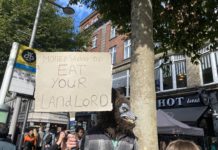Sam Leadbeater charts the story of how French football club Paris Saint-Germain suppressed its own fan base as it transformed from an expression of working class culture to an entertainment franchise.
An old video clip on YouTube shows the players from Paris Saint-Germain (PSG) walking out in front of their home stadium, les Parc des Princes. There is a considerable sense of occasion. As the camera pans over the hellfire pyrotechnics show engulfing the stands of the Virage Auteuil, the commentator remarks in heavily accented English – ‘welcome to the legendary fans’.
This was the 1990’s, the halcyon days of Parisian fan culture. Supporters groups such as Lutece Falco, Tigris Mystic, and Supras Auteuil competed for visual and vocal dominance in the stands, expressing their devotion, their fanaticism, to a city and club they lived their lives for.
These groups had superseded the less visually impressive and more violent ‘Boulogne Boys’ of the Kop of Boulogne (KOB), at the other end of the stadium. Since the 1980s this terrace had become a meeting place for the Parisian far right and it was a notorious hotbed of racism and fascism, supporters consciously aping the worse elements of English football culture. For many youths from the Parisian suburbs, or Banlieus, the Virage Auteuil was an alternative to this, where predominantly left wing and antiracist groups developed their own form of the ‘Ultra’ culture, which had its roots among football supporters in Italy.
For several seasons these two fan scenes, with their radically different social make-ups, political views, and cultures coexisted in relative peace. Until 2010, when a period of violence between the two groups, which had been instigated by racist attacks by the Boulogne fans on their racially mixed counterparts, led to the death, after a prolonged coma, of ‘Yann L’, a 38 year old Boulogne Hooligan. He had been attacked and badly beaten outside the les Parc des Princes by members of Supras Auteuil.
The Boulogne Boys had a history considerably more chequered by violence than their counterparts from the Auteuil, but for 20 years, the club had did little to combat the rise of fascism and racist violence in their stands. However when the moment presented itself in 2010, PSG was quick to implement its own version of ‘shock doctrine’ and used the tragic death to further an agenda of dragging the club into the era of “modern football” where television revenue and Gulf State money defines a club more than its supporters.
Following the death of ‘Yann L’ the Club and French authorities conspired to legally ‘dissolve’ all the major PSG fan groups – including Supras Auteuil, Authentiks, Karsud, and Tigris Mistik. Another fan group, Lutece Falco, disbanded shortly after, citing an untenable position due to the repression and media persecution they faced. The period also saw fan groups at other clubs similarly dissolved including the ‘Faction’ from Metz, ‘Cosa Nostra’ from Lyon, and ‘Brigade Sud Nice’. The opposition to these measures was fierce; thousands took to the streets of Paris in protest, and a wide scale boycott of the Parc was called by the fan groups (whose individual members had not yet received ‘Interdits des Stades’ – Stadium bans).
The next step by the club was to introduce random seating – you could no longer choose where you would sit – and the raising of ticket prices. Under the cover of ‘tous PSG’, a heavily marketed program of gentrification of the support, PSG sought, with the help of the Government and media to replace the hard-core supporters with ‘event customers’.
The media played an active role in the initial vilification of PSG supporters groups and their eventual dissolution. In December 2006 an article in Time magazine referred throughout to all Parisian fans involved in violence as ‘Ultras’ – despite the fact that at the time perhaps ten thousand Ultras supported PSG, with violence only a problem with a small minority.
![]() The article discussed the death of a Boulogne hooligan, shot by police, during anti-Semitic violence which accompanied a PSG UEFA Cup match against Hapoel Tel Aviv at the Parc des Princes. In a direct contradiction of the facts the article declared that ‘Supras d’Auteuil, (sic) Authentiks and similar fan associations’ contained in them a ‘hard core’ of “ultras” described as “hundreds of racismspewing thugs who regularly provoke violence both home and away, with rival club fans and even with black and Arab supporters of PSG’. In reality both the named groups have sizable amounts of black and Arab members.
The article discussed the death of a Boulogne hooligan, shot by police, during anti-Semitic violence which accompanied a PSG UEFA Cup match against Hapoel Tel Aviv at the Parc des Princes. In a direct contradiction of the facts the article declared that ‘Supras d’Auteuil, (sic) Authentiks and similar fan associations’ contained in them a ‘hard core’ of “ultras” described as “hundreds of racismspewing thugs who regularly provoke violence both home and away, with rival club fans and even with black and Arab supporters of PSG’. In reality both the named groups have sizable amounts of black and Arab members.
In a clear precursor of what was to soon become accepted Club and State policy the Time writer stated: “The real cure will require club, city, and police officials to take radical measures to force violent ultras into order, or away from stadia. As British efforts to vanquish hooliganism showed, coordinated identification of all known and potential thugs is essential to control their movements on game days and prevent attempts of banned fans from gaining access to stadia; better policing techniques adapted to soccer thugs are invaluable in defusing violent situations before they explode.’’
The use of the term ‘cure’ was consistent with the widely held media view of the PSG fan scene as a disease, not a social movement, which must be cured (destroyed), not understood. That ‘potential thugs’ and not only offenders were to be identified indicated that the called for approach was one in which all Ultras were to be declared the enemy.
Such an approach had come to fruition in England with the ‘association’ rule, where a person may be banned from attending football, and be subjected to police control on match days for merely knowing, or standing next to a football hooligan. These measures – stadium bans and match day control – can be carried out without a person ever seeing the inside of a court room, or even a police station.
When a similar approach was adopted in Paris it was unsurprisingly supported by a French right wing establishment that viewed radical football fans as something to be detested, denounced, and ultimately removed. However the failure of any left wing politician or academic to publicly support the supporters against theses draconian measures was more surprising.
In the 75th minute of a home game against Montpellier in May 2010, the Parisian Ultras displayed a spectacular act of defiance. Scores, perhaps hundreds, of red distress flares rained down from both Virages during the match, forcing play to be halted for a number of minutes. This act was a last hurrah, with on fan group, Lutece Falco displaying a banner which simply stated –‘This is the end’.




